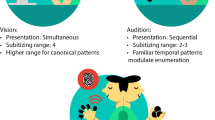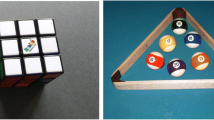Abstract
Previous research suggests that chimpanzees understand single invisible displacement. However, this Piagetian task may be solvable through the use of simple search strategies rather than through mentally representing the past trajectory of an object. Four control conditions were thus administered to two chimpanzees in order to separate associative search strategies from performance based on mental representation. Strategies involving experimenter cue-use, search at the last or first box visited by the displacement device, and search at boxes adjacent to the displacement device were systematically controlled for. Chimpanzees showed no indications of utilizing these simple strategies, suggesting that their capacity to mentally represent single invisible displacements is comparable to that of 18–24-month-old children.




Similar content being viewed by others
Notes
An additional session was required to repeat 12 mistrials revealed when video footage was coded. These were trials involving experimenter error or ambiguous responses (e.g., the object became temporarily visible as the displacement device was inserted beneath the target box, or the research assistant had failed to notice that the subject was not attending to the displacement). This session occurred 4 months later.
References
Call J (2001) Object permanence in orangutans (Pongo pygmaeus), chimpanzees (Pan troglodytes), and children (Homo sapiens). J Comp Psychol 115:159–171
Collier-Baker E, Davis JM, Suddendorf T (2004) Do dogs (Canis familiaris) understand invisible displacement? J Comp Psychol 118(4):421–433
de Blois ST, Novak MA (1994) Object permanence in rhesus monkeys (Macaca mulatta). J Comp Psychol 108:318–327
de Blois ST, Novak MA, Bond M (1998) Object permanence in orangutans (Pongo pygmaeus) and squirrel monkeys (Saimiri sciureus). J Comp Psychol 112:137–152
Doré FY (1986) Object permanence in adult cats (Felis catus). J Comp Psychol 100:340–347
Doré FY, Dumas C (1987) Psychology of animal cognition: Piagetian studies. Psychol Bull, 102:219–233.
Doré FY, Goulet S, Herman LM (1991) Permanence de l’objet chez deux dauphins (Tursiops truncatus ) (Object permanence in two dolphins). Paper presented at the XXIIIè Journées d’étude de l’Association de Psychologie Scientifique de Langue Française, Rome
Dumas C (1992) Object permanence in cats (Felis catus): An ecological approach to the study of invisible displacements. J Comp Psychol 106:404–410
Étienne AS (1973) Searching behaviour towards a disappearing prey in the domestic chick as affected by preliminary experience. Anim Behav 21:749–761
Gagnon S, Doré FY (1992) Search behaviour in various breeds of adult dogs (Canis familiaris): object permanence and olfactory cues. J Comp Psychol 106:58–68
Gagnon S, Doré FY (1993) Search behaviour of dogs (Canis familiaris) in invisible displacement tasks. Anim Learn Behav 21:246–254
Gagnon S, Doré FY (1994) A cross-sectional analysis of object permanence development in dogs (Canis familiaris). J Comp Psychol 108:220–232
Kramer JA, Hill KT, Cohen LB (1975) Infants’ development of object permanence: a refined methodology and new evidence for Piaget's hypothesized ordinality. Child Dev 46:149–155
Mathieu M, Bergeron G (1981) Piagetian assessment of cognitive development in chimpanzees (Pan troglodytes). In: Chiarell AB, Corrucini RS (eds) Primate behaviour and socio-biology. Springer, Berlin Heidelberg New York, pp 142–147
Mathieu M, Bouchard MA, Granger L, Herscovitch J (1976) Piagetian object-permanence in Cebus capucinus, Lagothrica flavicauda and Pan troglodytes. Anim Behav 24:585–588
Natale F, Antinucci F (1989) Stage 6 object-concept and representation. In: Antinucci F (ed) Cognitive structure and development in nonhuman primates. Erlbaum, Hillsdale, NJ, pp 97–112
Natale F, Antinucci F, Spinozzi G, Potì P (1986) Stage 6 object permanence in nonhuman primate cognition: a comparison between gorilla (Gorilla gorilla gorilla) and Japanese macaque (Macaca fuscata). J Comp Psychol 100:335–339
Nielsen M, Collier-Baker E, Davis JM, Suddendorf T (2005) Imitation recognition in a captive chimpanzee (Pan troglodytes). Anim Cogn 8:31–36
Neiworth JJ, Steinmark E, Basile BM, Wonders R, Steely F, DeHart C (2003) A test of object permanence in a new-world monkey species, cotton top tamarins (Saguinus oedipus). Anim Cogn 6:27–37
Pepperberg IM (2002) The value of the Piagetian framework for comparative cognitive studies. Anim Cogn 5:177–182
Pepperberg IM, Funk MS (1990) Object permanence in four species of psittacine birds: an African grey parrot (Psittacus erithacus), an Illiger mini macaw (Ara maracana), a parakeet (Melopsittacus undulatus), and a cockatiel (Nymphicus hollandicus). Anim Learn Behav 18:97–108
Pepperberg IM, Kozak FA (1986) Object permanence in the African grey parrot (Psittacus erithacus). Anim Learn Behav 14:322–330
Pepperberg IM, Willner MR, Gravitz LB (1997) Development of Piagetian object permanence in a grey parrot (Psittacus erithacus). J Comp Psychol 111:63–75
Perner J (1991) Understanding the representational mind. Bradford/MIT, Cambridge, MA
Piaget J (1954) The construction of reality in the child (M. Cook, translation). Basic Books. New York (Original work published 1937)
Pollok B, Prior H, Gunturkun O (2000) The development of object permanence in food-storing magpies (Pica pica). J Comp Psychol 114:148–157
Redshaw M (1978) Cognitive development in human and gorilla infants. J Human Evol 7:133–141
Suddendorf T (1999) The rise of the metamind. In: Corballis MC, Lea SEG (eds) The descent of mind: psychological perspectives on hominid evolution. Oxford University Press, London, pp 218–260
Suddendorf T (2004) How primatology can inform us about the evolution of the human mind. Aust Psychol 39:180–187
Suddendorf T, Whiten A (2001) Mental evolution and development: evidence for secondary representation in children, great apes and other animals. Psychol Bull 127:629–650
Suddendorf T, Whiten A (2003) Reinterpreting the Mentality of Apes. In: Fitness J, Sterelny K (eds) From mating to mentality: evaluating evolutionary psychology. Psychology Press, New York, pp 173–196
Wildman DE, Uddin M, Grossman LI, Goodman M (2003) Implications of natural selection in shaping 99.4% nonsynchronous DNA identity between humans and chimpanzees: enlarging genus Homo. Proc Natl Acad Sci USA 100:7181–7188
Wise KL, Wise LA, Zimmermann RR (1974) Piagetian object permanence in the infant rhesus monkey. Dev Psychol 10:429–437
Wood S, Moriatry KM, Gardner BT, Gardner RA (1980) Object permanence in child and chimpanzee. Anim Learn Behav 8:3–9
Acknowledgements
This research was supported by Australian Research Council Discovery Grant (DP0208300) awarded to Thomas Suddendorf. We sincerely thank the Rockhampton Botanical Gardens and Zoo for allowing us to use their facilities and work with Cassie and Ockie. These experiments comply with the current laws of Australia regarding the use of animals in research
Author information
Authors and Affiliations
Corresponding author
Rights and permissions
About this article
Cite this article
Collier-Baker, E., Davis, J.M., Nielsen, M. et al. Do chimpanzees (Pan troglodytes) understand single invisible displacement?. Anim Cogn 9, 55–61 (2006). https://doi.org/10.1007/s10071-005-0004-5
Received:
Revised:
Accepted:
Published:
Issue Date:
DOI: https://doi.org/10.1007/s10071-005-0004-5




